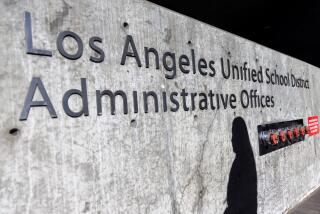Schools Use Variety of Anti-Drug Tactics : S.D. Educators Praise Bush Speech but Stress Need for Broad Approach
- Share via
A panoply of drug prevention programs are in place throughout San Diego County schools, and educators believe they are gradually having a cumulative effect in cutting student acceptance of drug and alcohol use, particularly at the elementary level.
School administrators welcomed the emphasis that President Bush placed on the anti-drug effort Tuesday night, but stressed that their experiences show success depends on a variety of educational approaches and not a single strategy.
The best “bang for the buck” comes at the elementary level, and you can never start too soon, Carol Pugmire, assistant superintendent for the San Diego County Office of Education, said Tuesday.
The county office, which offers assistance in curriculum and health for many of the county’s 43 school districts, wants to customize its offerings this year and help more districts strengthen their elementary programs. It will offer to examine existing programs in all districts this fall and draw up stronger prevention plans.
The Goal for Schools
“I think every school in the county does something,” Pugmire said. “But many are programs at the junior and high school levels that are taught more as deterrence and intervention. At the elementary level, you can integrate the material into the kids’ feelings about themselves and about self-esteem to get them to say no later.”
Pugmire said the goal, both countywide and at the state level, is to show students that drug education is central to overall physical and mental health--including nutrition, sexual activity and general habits--as part of the “Healthy Kids, Healthy California” initiative of the state Department of Education.
Elementary school programs represent the main thrust of those offered by the San Diego Unified School District, the nation’s eighth largest with 118,000 of the county’s 382,000 students.
In addition to regular units on substance abuse at each elementary grade, the district now offers, in cooperation with the San Diego Police Department, a special program for all fifth- and sixth-graders. The DARE program (Drug Abuse Resistance Education) has been hailed for its ability to show kids the link between drug use and self-esteem and peer pressure in Los Angeles-area schools, where it originated.
“There never is going to be one single program you can utilize and call it a panacea, but the DARE has been a tremendous asset and, in a recent (outside) evaluation of all of our pro grams, it has been ranked right at the top,” said Earl Krepelin Jr., the San Diego districts’s coordinator of Social Concerns programs.
The DARE program also operates in the San Ysidro and Poway school districts because much of those districts are covered by San Diego police units.
With a budget of more than $1.5 million planned for the upcoming school year, San Diego also has set up Just Say No clubs at 56 elementary schools to offer students positive peer groupings, expanded a separate drug awareness program at schools in areas with significant gang activity and drawn up plans to expand a joint family-counseling program with San Diego State University graduate students in social work.
“The success of all of these programs is directly related to the coordination of agencies in the community,” Krepelin said, adding that many hospitals and drug-intervention agencies offer classroom presentations that schools now eagerly seek for their campuses.
Central Information Point
“Schools are increasingly becoming the central information point, if you will, for these efforts, and not just for students but for the parents as well,” Krepelin said.
But San Diego lags in secondary drug education, Tom Payzant, district superintendent, admitted Tuesday. There are now no required drug education programs after the eighth grade. Prodded by the Board of Education, in particular by member Ann Armstrong, a committee of district administrators is designing a required high school course.
“We need (a course) but I believe that a high school-level course should not be just on drugs but deal with the whole range of decision-making, of self-esteem, of choices that these young people are confronting,” Payzant said. Another sticky issue is where to place such a course, since teachers of math or English or history are loathe to sacrifice their time for additional social-concern education, he said.
Krepelin said that, despite the lack of required formal anti-drug courses, students at many high schools now sponsor anti-drug rallies through their student body organizations, at dances and through campus newspapers.
More to Read
Sign up for Essential California
The most important California stories and recommendations in your inbox every morning.
You may occasionally receive promotional content from the Los Angeles Times.













